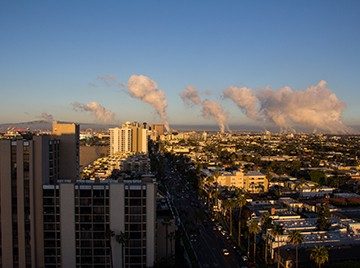FOR IMMEDIATE RELEASE
ACS News Service Weekly PressPac: March 09, 2022
Historically ‘redlined’ urban areas have higher levels of air pollution
“Historical Redlining Is Associated with Present-Day Air Pollution Disparities in U.S. Cities”
Environmental Science & Technology Letters
In the wake of the Great Depression, the federally sponsored Home Owners’ Loan Corporation (HOLC) drew maps of neighborhoods in U.S. cities that characterized their desirability for mortgage lending. Many neighborhoods with Black and immigrant communities received the worst grade, restricting access to federally backed loans and favorable mortgage terms. Now, researchers reporting in ACS’ Environmental Science & Technology Letters have found that these “redlined” areas have higher levels of air pollution 80 years later.
In the U.S., people of color, particularly Black and Hispanic Americans, at every income level are exposed to higher-than-average amounts of air pollution. The reasons are complex and partly rooted in historical patterns of discrimination, experts say. Beginning in the 1930s, the HOLC rated neighborhoods in U.S. cities on a four-point scale: “A” (most desirable), “B” (still desirable), “C” (definitely declining) and “D” (hazardous for mortgage appraisal; “redlined”). Historical records indicate that many neighborhoods were given the “D” characterization because they had Black and immigrant communities. This designation limited residents’ ability to build wealth through home ownership, and it also influenced later government land use decisions to place hazardous industries in or near “D” neighborhoods. Joshua Apte of the University of California, Berkeley and colleagues wanted to examine associations between historical redlining and air pollution levels in the year 2010, which had the most recent census data available at the time of the study.
The researchers focused on two key air pollutants — nitrogen dioxide (NO2; a short-lived gas emitted by traffic, industry and other sources), and fine particulate matter (PM2.5; longer-lived, tiny particles found in dust, soot, smoke and other emissions, and also formed in the atmosphere). The team compared 1930s-era HOLC maps with 2010 air pollution levels and census demographics for 202 U.S. cities that are home to 65% of the urban population. They found that pollution levels were consistently linked with HOLC grade, especially for NO2, which was 50% higher in “D” neighborhoods than in “A” ones. At the national level, air pollution disparities were larger by HOLC grade than they were by race and ethnicity. However, within each grade, racial and ethnic disparities were observed, with lower exposure levels to NO2 and PM2.5 for white people than for people of color. Overall, the authors emphasize that present-day air pollution disparities in part reflect decisions made generations ago.
The authors acknowledge funding from the U.S. Environmental Protection Agency.
###
The American Chemical Society (ACS) is a nonprofit organization chartered by the U.S. Congress. ACS’ mission is to advance the broader chemistry enterprise and its practitioners for the benefit of Earth and all its people. The Society is a global leader in promoting excellence in science education and providing access to chemistry-related information and research through its multiple research solutions, peer-reviewed journals, scientific conferences, eBooks and weekly news periodical Chemical & Engineering News. ACS journals are among the most cited, most trusted and most read within the scientific literature; however, ACS itself does not conduct chemical research. As a leader in scientific information solutions, its CAS division partners with global innovators to accelerate breakthroughs by curating, connecting and analyzing the world’s scientific knowledge. ACS’ main offices are in Washington, D.C., and Columbus, Ohio.
To automatically receive press releases from the American Chemical Society, contact newsroom@acs.org.
Note: ACS does not conduct research, but publishes and publicizes peer-reviewed scientific studies.
Media Contact
ACS Newsroom
newsroom@acs.org


